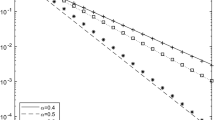Abstract
The performance evaluation of many complex manufacturing, communication and computer systems has been made possible by modeling them as queueing systems. Many approximations used in queueing theory have been drawn from the behavior of queues in light and heavy traffic conditions. In this paper, we propose a new approximation technique, which combines the light and heavy traffic characteristics. This interpolation approximation is based on the theory of multipoint Padé approximation which is applied at two points: light and heavy traffic. We show how this can be applied for estimating the waiting time moments of the GI/G/1 queue. The light traffic derivatives of any order can be evaluated using the MacLaurin series analysis procedure. The heavy traffic limits of the GI/G/1 queue are well known in the literature. Our technique generalizes the previously developed interpolation approximations and can be used to approximate any order of the waiting time moments. Through numerical examples, we show that the moments of the steady state waiting time can be estimated with extremely high accuracy under all ranges of traffic intensities using low orders of the approximant. We also present a framework for the development of simple analytical approximation formulas.
Similar content being viewed by others
References
G.A. Baker, Essentials of Padé Approximants (Academic Press, 1975).
D.Y. Burman and D.R. Smith, A Light-traffic theorem for multi-server queues, Math. Oper. Res. 8 (1983) 15–25.
K.W. Fendick and W. Whitt, Measurements and approximations to describe the offered traffic and predict the average workload in a single-server queue, Proceedings of the IEEE 77(1) (1989) 171–194.
K.W. Fendick, V.R. Saksena and W. Whitt, Dependence in packet queues, IEEE Transactions on Communications 37 (1989) 1173–1183.
M.K. Girish and J.Q. Hu, Higher order approximations for tandem queueing networks, Queueing Systems 22 (1996) 249–276.
M.K. Girish and J.Q. Hu, The departure process of the MAP/G/1 queue, submitted to Journal of DEDS (1996).
W.B. Gong and J.Q. Hu, The MacLaurin series for the GI/G/1 queue, J. Appl. Probab. 29 (1992) 176–184.
W.B. Gong, A. Yan and D. Tang, Rational representations for performance functions of queueing systems, in: Princeton Conference on System & Information Sciences (1992).
W.B. Gong, S. Nananukul and A. Yan, Padé approximation for stochastic discrete event systems, IEEE Trans. Automat. Control 40(8) (1995) 1349–1358.
J.M. Harrison and V. Nguyen, The QNET method for two-moment analysis of open queueing networks, Queueing Systems 6 (1990) 1–32.
J.M. Harrison and M.I. Reiman, Reflected brownian motion on an orthant, Ann. Probab. 9 (1981) 302–308.
J.Q. Hu, Analyticity of single-server queues in light traffic, Queueing Systems 19 (1995) 63–80.
J.Q. Hu, The departure process of the GI/G/1 queue, Oper. Res. 44(5) (1996) 810–815.
L. Kleinrock, Queueing Systems, Vol. 2 (Addison-Wesley, 1975).
P.J. Kuehn, Approximate analysis of general queueing networks by decomposition, IEEE Transactions on Communications COM-27 (1979) 113–126.
K.T. Marshall, Some inequalities in queueing, Oper. Res. 16 (1968) 651–665.
P.P. Petrushev and V.A. Popov, Rational Approximation of Real Functions (Cambridge Univ. Press, 1987).
M.I. Reiman and B. Simon, Open queueing systems in light traffic, Math. Oper. Res. (1988).
M.I. Reiman and B. Simon, An interpolation approximation for queueing systems with poisson input, Oper. Res. 36(3) (1988) 454–469.
M.I. Reiman and A. Weiss, Light traffic derivatives via likelihood ratios, IEEE Trans. Inf. Technol. 35 (1989) 648–654.
W. Whitt, The queueing network analyzer, The Bell System Technical Journal 62(9) (1983) 2779–2815.
W. Whitt, An interpolation approximation for the mean workload in the GI/G/1 queue, Oper. Res. 37(6) (1989) 936–952.
Y. Zhu and H. Li, The MacLaurin expansion for a G/G/1 queue with Markov-modulated arrivals and services, Queueing Systems (1993) 125–134.
Author information
Authors and Affiliations
Rights and permissions
About this article
Cite this article
Girish, M.K., Hu, JQ. An interpolation approximation for the GI/G/1 queue based on multipoint Padé approximation. Queueing Systems 26, 269–284 (1997). https://doi.org/10.1023/A:1019137309293
Issue Date:
DOI: https://doi.org/10.1023/A:1019137309293




